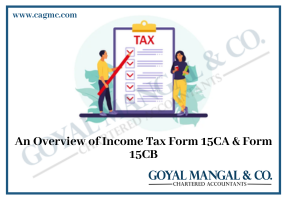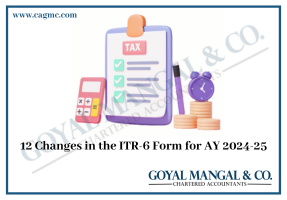
Taxation is an essential aspect of any modern economy, and the United States is no exception. The U.S. tax system is complex, with a wide range of tax laws, regulations, and procedures. For individuals living and working in the United States, understanding U.S. taxation is crucial. In this article, we’ll provide an overview of U.S. taxation for individuals, including the types of taxes that individuals are required to pay and some tips for reducing tax liability.
Quick Look
The Federal, State, and Municipal Governments in the United States of America are distinct from one another, and taxes are levied at each of these levels. Income, Wages, Property, Sales, Capital Gains, Dividends, Imports, Estates, and Gifts are all subject to taxes, in addition to several other charges.
Taxes fall much more heavily on labour income than on capital income. Divergent taxes and subsidies for different forms of income and spending can also constitute a form of indirect taxation of some activities over others. For Example can be “taxed” at a high rate when contrasted to other types of personal expenditure that are explicitly recognized as investments.
The current taxation system in the United States
In the United States, there are three sorts of taxes: Federal, State, and Local. Federal taxes are levied by the Federal Government, whereas state and local taxes are levied by individual states and local governments.
- Federal Taxation: Income Tax, Payroll Tax, Corporation Tax, an Estate Tax, and Gift Tax are all examples of Federal taxes. The largest major source of government revenue is income tax, which is determined based on a person’s or businesses taxable income. The payroll tax is a levy on wages and salaries that is used to support the Social Security and Medicare programs. Corporate tax is a levy on corporate earnings. The estate tax is levied on the transfer of property after a person’s death, whereas the gift tax is levied on gifts made during a person’s lifetime.
- State Taxation: State taxes differ per state, although most levy an income tax, a sales tax, and a property tax. Property tax is a tax on real estate and other property, whereas sales tax is a tax on products and services supplied in the state.
- Local Taxation: local income taxes levied by cities and counties.
U.S. Taxation For Individuals: Taxable Income
In the United States, individuals are subject to Income Tax based on their taxable income, which is calculated by subtracting deductions and exemptions from their gross income.
The federal, most state, and some local governments levy taxes on the net income of individuals and corporations. Citizens and residents are taxed on their worldwide income and are entitled to a credit for international taxes paid.
Taxable income is defined by tax accounting regulations rather than financial accounting principles, and it includes practically all revenue from any source. Individuals can deduct personal allowances and some non-business costs from their taxable income.
The income of a US resident is normally taxed in the same way as that of a US citizen. If you live in the United States, you must record all interest, dividends, wages, or other pay for services, income from rental property or royalties, and other types of income on your federal income tax return. These sums must be reported whether earned within or outside the United States.
How are taxes collected in the United States?
The Internal Revenue Service (IRS) is in charge of collecting federal taxes, while state and local tax authorities are in charge of collecting state and local taxes. Payroll deductions, anticipated tax payments, and tax withholding are all ways that taxes are collected.
Payroll deductions are deductions made directly from an employee’s paycheck for federal income tax, Social Security tax, and Medicare tax. Estimated tax payments are quarterly payments made by self-employed persons or those who earn income that is not subject to withholding tax. Employers utilize tax withholding to deduct federal and state income taxes from an employee’s pay check.
The tax collecting procedure in the United States is simple. Every year, citizens and corporations must file their taxes by April 15th. The tax return details the income and deductions of the person or corporation. This information is used by the IRS to calculate the amount of tax payable.
The IRS will either approve or reject the tax return after it is filed. If the tax return is approved, the taxpayer must pay the balance outstanding by the due date. If the tax return is denied, the taxpayer must remedy any mistakes and resubmit the form.
Who is in charge of Paying Taxes?
Every American individual and corporation is accountable for paying their fair amount of taxes. Individuals are responsible for paying federal income tax on taxable income, while businesses are responsible for withholding and paying payroll taxes on their employees’ behalf.
Businesses must pay federal and state taxes on earnings, as well as payroll taxes on behalf of their employees. Other taxes, such as excise taxes, which are levied on specific goods and services, may apply to some firms.
U.S. Taxation For Individuals: Types of Taxes for Individuals
The U.S. federal government levies several types of taxes on individuals. These include:
- Income Tax: The U.S. federal income tax is a tax on an individual’s income. The tax is calculated based on a person’s taxable income, which is their total income minus any deductions and exemptions they are eligible for. Income tax rates vary based on income level and filing status.
- Social Security Tax: Social Security tax is a tax on an individual’s wages or self-employment income that goes toward funding the Social Security program. In 2022, the Social Security tax rate is 6.2% for both employees and employers, with a maximum wage base of $147,000.
- Medicare Tax: Medicare tax is a tax on an individual’s wages or self-employment income that goes toward funding the Medicare program. In 2022, the Medicare tax rate is 1.45% for both employees and employers, with no maximum wage base.
- State and Local Taxes: In addition to federal taxes, individuals may also be required to pay state and local taxes. State taxes can include income, sales, and property taxes, among others. Local taxes may include property taxes, sales taxes, and occupational taxes.
- Estate and Gift Taxes: Estate and gift taxes are taxes on the transfer of wealth. Estate taxes are paid by the estate of a deceased person, while gift taxes are paid by the person making the gift.
U.S. Taxation For Individuals: Deductions available for Individuals
Individuals in the United States can claim deductions on their federal income tax returns to reduce their taxable income. Individuals can take advantage of various deductions such as:
- Itemized Deduction: Itemized deductions are qualified costs that individual taxpayers can claim on federal income tax returns to reduce their taxable income and are claimable in lieu of a standard deduction, if available, under US tax law. Home mortgage interest, state and local taxes, and charitable contributions are examples of itemized deductions Most taxpayers have the option of choosing between itemized deductions and the basic deduction. After calculating their AGI (Adjusted Gross Income), taxpayers can itemize deductions (from a list of permitted items) and subtract those itemized deductions from their AGI to determine their taxable income.
They can also choose to deduct the standard deduction for their filing status to calculate their taxable income. In other words, the taxpayer may normally deduct the greater of the entire itemized deduction amount or the appropriate standard deduction amount.
- Standard Deduction: The standard deduction is a dollar amount that non-itemizers may deduct from their income before income tax (but not other types of tax, such as payroll tax) is imposed under US tax law. Taxpayers can select between itemized deductions and the standard deduction, although they normally choose the option that results in the lowest amount of tax payable. Individuals who are US citizens or resident aliens are eligible for the standard deduction.
The standard deduction is depending on filing status and normally increases each year based on prior year inflation measurements. It is not available to non-resident immigrants in the United States however few exceptions are there, like as students from India on F1 visa status who can use the standard deduction. Additional amounts are available for persons who are blind and/or are at least 65 years of age. Individuals are also entitled to a fixed amount allowance for personal exemptions. The allowance of some non-business deductions is phased out at higher income levels.
U.S. Taxation for Individuals: Levels and Types of Taxation
The United States is divided into federal, state, municipal, and special-purpose governmental authorities. Each levy taxes to fund its operations entirely or partially. These taxes may be applied on the same income, property, or activity, with no offset between them.
The sorts of taxes levied at each level of government differ, in part due to constitutional constraints. Income taxes are levied at both the federal and state levels. Property taxes are normally enforced only at the municipal level, though many local jurisdictions may tax the same property.
Other excise taxes are levied by the federal government and several states. Most states and many local governments levy sales taxes. Customs charges or tariffs are only imposed by the government. Customs duties or tariffs are only imposed by the federal government. A wide variety of user fees or license fees are also imposed.
U.S. Taxation For Individuals: Tax Brackets for Individuals
The U.S. has a progressive income tax system, which means that individuals with higher incomes pay a higher percentage of their income in taxes. The income tax is divided into several tax brackets, each with its own tax rate.
For the tax year 2022, the tax brackets and rates for single filers are as follows:
- 10% on taxable income up to $10,425
- 12% on taxable income between $10,425 and $40,425
- 22% on taxable income between $40,425 and $86,375
- 24% on taxable income between $86,375 and $164,925
- 32% on taxable income between $164,925 and $209,425
- 35% on taxable income between $209,425 and $523,600
- 37% on taxable income over $523,600
U.S. Taxation for Individuals: Claiming Exemptions
Individuals in the United States can use personal exemptions as a tax deduction against personal income when determining taxable income and federal income tax. In general, the taxpayer and eligible dependents can claim a personal exemption.
A spouse may also claim a personal exemption if the pair files separately, the spouse has no gross income, and the spouse is not a dependent of another taxpayer. The personal exemption, however, was repealed in 2018 as part of the Tax Cuts and Jobs Act. Aside from personal exemptions, taxpayers may claim other deductions to lower the amount of income due to taxation. Individual taxpayers can claim itemized deductions on their federal income tax filings, which reduce their taxable income.
U.S. Taxation for Individuals: Tax Credit
Tax credits can be claimed by taxpayers in the United States to lower their federal income tax payment. There are tax credits available at both the federal and state levels12. Some tax credits, such as the child tax credit for each dependent child, the American Opportunity Tax Credit for college expenses, and the Earned Income Tax Credit for low-income wage earners, are only accessible to individuals.
U.S. Taxation for Individuals: Forms & Due Dates
Individual taxpayers in the United States must file their federal income tax returns using Form 1040, U.S. Individual Income Tax Return. The annual deadline for filing one’s Federal individual income tax return is April 15, unless April 15 happens on a Saturday, Sunday, or legal holiday, in which case the reports are due the next business day.
Form 4868, Application for Automatic Extension of Time to File U.S. Individual Income Tax Return, can be used to request an automatic extension until October 15 to file Form 1040. Only if the form shows federal income tax withheld must taxpayers attach informational returns to their individual federal income tax returns. Employers must mail Form W-2 to employees by January 31, giving these taxpayers approximately two months to file their returns before the April 15 deadline.
Conclusion
U.S. taxation for individuals can be complex, but understanding the different types of taxes and tips for reducing tax liability can help individuals navigate the system. By taking advantage of deductions and credits, contributing to retirement accounts, investing in tax-advantaged accounts, and timing income and expenses, individuals can reduce their tax liability and keep more of their hard-earned money.







